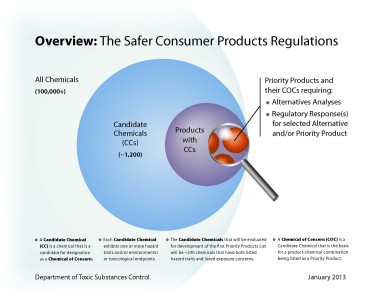New Chemical Regulations Go Live in California
Making Prevention Real?
 Today, after years of discussions and drafts, California’s new Safer Consumer Product regulations take effect. They create a comprehensive chemicals regulatory scheme having three steps: identification and prioritization of consumer products containing chemicals of greatest concern (“product-chemical combinations”); performance of “alternative analyses” by the manufacturers of those high priority product-chemical combinations; and selection of regulatory responses including outright bans, use restrictions, information disclosure, end of life management programs and other interventions.
Today, after years of discussions and drafts, California’s new Safer Consumer Product regulations take effect. They create a comprehensive chemicals regulatory scheme having three steps: identification and prioritization of consumer products containing chemicals of greatest concern (“product-chemical combinations”); performance of “alternative analyses” by the manufacturers of those high priority product-chemical combinations; and selection of regulatory responses including outright bans, use restrictions, information disclosure, end of life management programs and other interventions.
In a way it is a remarkable story; a bill that seemed to come out of nowhere establishes a radically new (although in some ways deeply flawed) regulatory framework; an agency with limited experience in the area and shockingly little funding takes on major reform at the cutting edge of chemical policy; and a set of regulations that, despite years of tumult and uncertainty, create what appears to be a workable program. To be sure the regulations have some significant problems, a fair number of which reflect the agency’s adaptation to minimal funding and weak authority. More on that in later posts. But just the fact that these regulations are now law is cause to pause and appreciate.
What is so remarkable is this program? A few things. First, it adopts a comparative perspective. Federal toxics law takes a product as it comes and asks is it safe enough. Defining a “safe” level is typically fraught with scientific uncertainties and political controversies, and in the long run often turns out to be under-protective. California asks instead whether there is an alternative that is safer. Second, the program embraces the “prevention principle,” the notion that all things being equal, it is better to avoid use of a toxic material all together than to try to control exposure through engineering controls, use restrictions, and labels. The prevention principle (not to be confused with the precautionary principle) is implicitly embedded in many of our major federal statutes, but uniformly ignored in practice. The California regulations explicitly adopt it, making it a central decision rule guiding selection of regulatory responses:
“In selecting regulatory responses, the Department shall give preference to regulatory responses providing the greatest level of inherent protection. For these purposes, “inherent protection” refers to avoidance or reduction of adverse impact . . . that is achieved through the redesign of a product or process, rather than through administrative or engineering controls designed to limit exposure to, or the release of, a [toxic chemical]….”
Sure there are limits and caveats on how it to be applied later in the regulations, raising the question of whether the prevention principle will be brought to life in practice, or remain an aspirational statement. Fair enough, but its placement front and center in the regulatory language itself is an awfully good start.








Reader Comments